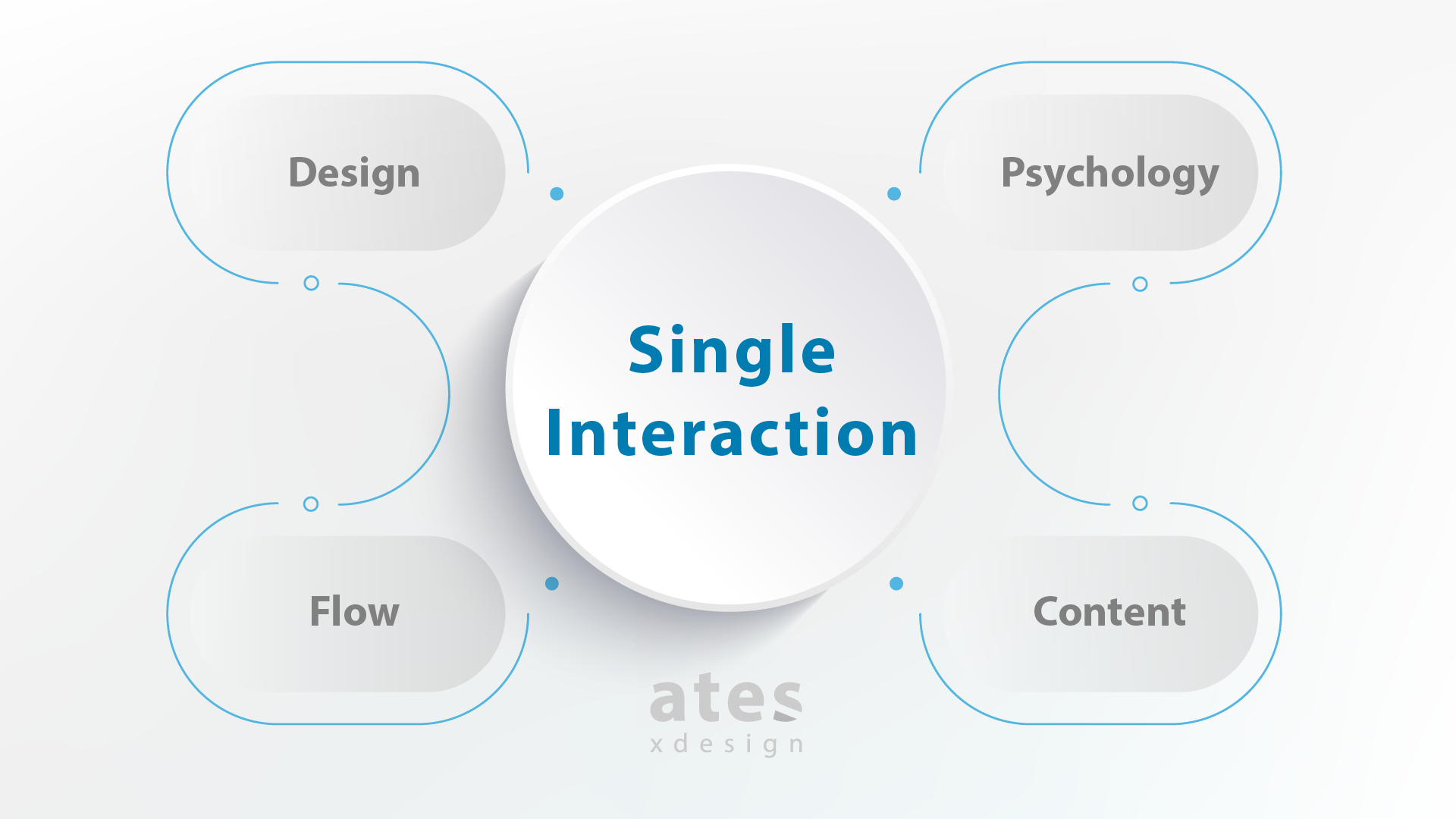We can divide the types (levels) of experience your User / Customer has with your products and services, and therefore with you, from simple to complex, into three steps;
- Single-Interaction
- Customer-Journey
- Relationship
Fact : Classifications like these are made so that the topics can be easily understood. Do not accept these as the only and unchangeable truth, but pay attention to them.
1. Single Interaction
A specific device, a specific purpose.
This is the level defined as UX (User Experience) almost everywhere. It deals with the achievement of a particular purpose by a person and the device he or she uses for it. It tries to improve all steps related to purpose and device.
The correct methodology is to separate the entire scope as User and Experience and to mature it with sub-headings. Here, we consider the UX topic in its most basic form without separating it.

- Design : It refers to the shaping of what you see on the screen in the digital world, and everything you can hold and see in the physical world. Usability is the strongest title. It appeals to the aesthetic perception. It is the first sign of respect for your user and yourself.
- Psychology: Whatever we do, there are reactions inside our brains behind it. Psychology is also a science of mind and behavior that completely concerns the brain. It is an experience designer’s most mysterious weapon. A designer who understands the psychology of the user, what he reacts to and how he acts, acts as if he has a magic wand while developing products and services. We’re going to talk about this a lot more.
- Flow: It is a pattern of organized and repeatable activity. Every step you take from A to B, and the path itself, can be seen as a flow. The most basic flow example is the process of searching for and meeting the need of a person who enters a website. It should be seamless and flowing.
- Content: All kinds of information, texts and all kinds of elements you provide through your channels are considered as content. You should see the content as a body of information, because a diagram you put in can also be considered as content. The language used, as well as the scope of the content, is crucial to the complete experience.
You can't design experience just by focusing on UX.
2. Customer-Journey
Different interaction channels and/or devices.
This is the most important level. It refers to the journey of the customer trying to reach a goal using different channels and devices.
'Channel' Do not confuse the terminology. Website is a channel, mobile application is a channel, call center (phone), chat, e-mail are all channels. Everything the company reaches out to you and you reach the company is a channel.
In some places, this level is called CX (Customer Experience). User or customer? As you can see the distinction is not very clear. For this reason, we will try to use only the concept of Experience as much as we can in order not to cause terminological confusion.
our real focus should be on the customer journey explored in this topic. You cannot manage your customers and your business with only UX / UI (UI: User Interface) issues. Essentially, you have to manage the harmony between your channels. In order to manage this harmony;
- Your cross-channel messages and information should be consistent.
- The language, words and sentences you use in your channels should be compatible.
- Transitions between your channels should be fluid.
- Look, feel and overall experience must be in harmony
- A strong infrastructure should be used to ensure a seamless experience over and over again.
3. Relationship
It refers to all communication, all interaction between the company and the customer.
With this level, we begin to build a full-fledged business. Because the relationship level doesn’t just examine the path to the product. It doesn’t just focus on one goal. It handles the entire relationship between your company and your customer. It has a past, present and future.
Searching and finding your products and services, purchasing, using, getting support for products, solving problems, offering other products and services, etc. all stages take place at this level.
Conclusion
The level of experience your customer will have with your company can be examined under three headings as follows. Each title includes the previous one. You should plan and design to the last level as much as possible according to the scope of your work and project.
- Single-Interaction
- Customer-Journey
- Relationship
References :
Salazar, Kim (2019). User Experience vs. Customer Experience: What’s The Difference?. NNGroup.

